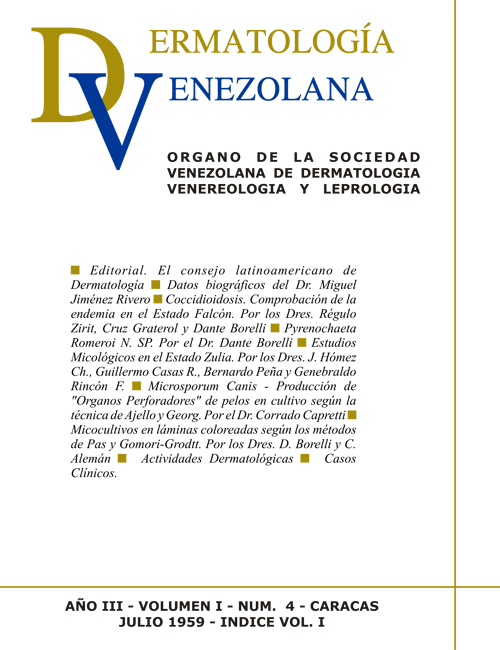PYRENOCHAETA ROMEROI N. SP.
Palabras clave:
Pyrenochaeta romeroi, micetoma, Maclaao aia ottonisResumen
Trabajo de la Cátedra de Microbiología y Parasitología (Prof. Dr. Leopoldo Briceño Iragorri) del Instituto de
Medicina Tropical (Director: Dr. Félix Pifano), de la Escuela de Medicina, Universidad Central de Venezuela, Caracas.
ABSTRACT
From a black grained mycetoma pedis in a male labourer (all life resident of Paraguana
peninsula, in the Northern part of Venezuela) a mold has been repeatedly isolated in pure
culture, which appear to be the type of a new species, to which the name has been
assigned of Pyrenochaeta romeroi. English translation of Latin diagnosis follows:
Grains in mycetoma are black, soft, tubular, enrolled, 0,5 to 1,5 mm. in diameter.
Colonies are woolly, grey-dark, rapidly growing, with whitish periphery and black reverse.
Optimal growth temperature aprox. at 309C; maximal growth temperature: somewhat below
389C.
Pycnidia are superficial, solitary or grouped, ostiolated, externally brown-black, internally
subhyaline, 50-165 x 40-100 M, big, everywhere surrounded with brown, straight or flexuous,
septated setae with round extremities. Pycnoconidia are subhyaline, ellipsoid, continuous,
1,5-2 x 0,75-1 1L big, yellow and catenulated when in a mass, produced on the tips of thin,
simple, hyaline, hardly visible conidiophores.
Source: a mycetoma of a foot, secondary to a wound produced by a thorn of Palito
blanco tree (Machaonia ottonis Urban).
Descargas
Número
Sección
Licencia
Publicado por la Sociedad Venezolana de Dermatología Médica, Quirúrgica y Estética







